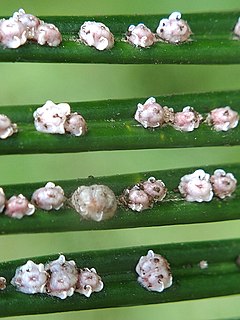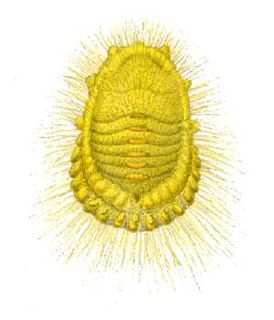
Hemiptera or true bugs are an order of insects comprising over 80,000 species within groups such as the cicadas, aphids, planthoppers, leafhoppers, bed bugs and shield bugs. They range in size from 1 mm (0.04 in) to around 15 cm (6 in), and share a common arrangement of sucking mouthparts. The name "true bugs" is often limited to the suborder Heteroptera. Many insects commonly known as "bugs", especially in American English, belong to other orders; for example, the lovebug is a fly and the May bug and ladybug are beetles.

Scale insects are small insects of the order Hemiptera, suborder Sternorrhyncha. Of dramatically variable appearance and extreme sexual dimorphism, they comprise the superfamily Coccoidea. Adult females typically have soft bodies and no limbs, and are concealed underneath domed scales, extruding quantities of wax for protection. Some species are hermaphroditic, with a combined ovotestis instead of separate ovaries and testes. Males, in the species where they occur, have legs and sometimes wings, and resemble small flies. Scale insects are herbivores, piercing plant tissues with their mouthparts and remaining in one place, feeding on sap. The excess fluid they imbibe is secreted as honeydew on which sooty mold tends to grow. The insects often have a mutualistic relationship with ants, which feed on the honeydew and protect them from predators. There are about 8,000 described species.

The Margarodidae or ground pearls are a family of scale insects within the superfamily Coccoidea. Members of the family include the Polish cochineal and Armenian cochineal and the original ground pearl genus, Margarodes. Beginning in 1880, a number of distinct subfamilies were recognized, with the giant coccids being the first. Although Maskell proposed a new family, many continued to regard the monophlebids as a mere subfamily for many years, and the Margarodidae classification continued to be polyphyletic through the 20th Century. Since then, taking the advice of Koteja several subfamilies and tribes have been elevated into their own families such as Matsucoccidae and Xylococcidae. The pared-down family of Margarodidae is monophyletic.
Paratachardina pseudolobata, the lobate lac scale, is a polyphagous and pestiferous lac scale insect, which damages trees and woody shrubs in Cuba, Florida, the Bahamas and the Australian territory of Christmas Island. It was mistakenly identified as Paratachardina lobata (Chamberlin), an insect native to India and Sri Lanka, but was in 2007 recognized and named as a distinct species based on material from Florida; its native distribution is as yet unknown. The new lac insect was described based on all stages of the female, during the revision of the genus Paratachardina, wherein all its known species were redescribed.

Psocodea is a taxonomic group of insects comprising the bark lice, book lice and true lice. It was formerly considered a superorder, but is now generally considered by entomologists as an order. Despite the greatly differing appearance of Phthiraptera lice, they are believed to have evolved from within the former order Psocoptera, which contained the bark lice and book lice, now found to be paraphyletic. Psocodea contains around 11,000 species, divided among seven suborders.

Eriococcidae is a family of scale insects in the order Hemiptera. They are commonly known as felt scales or eriococcids. Each species is usually specific to a different plant host, or closely related group of hosts.

Monophlebidae is a family of scale insects commonly known as the giant scales or monophlebids. They occur in most parts of the world but more genera are found in the tropics than elsewhere.
Phenacoleachiidae is a family of scale insects commonly known as the phenacoleachiids. They are found only in the South Island of New Zealand, and on certain offshore islands. There are two species in a single genus.
Putoidae is a family of scale insects commonly known as giant mealybugs or putoids. There is probably a single genus, Puto, containing about sixty species. The genus name Macrocerococcus has also been used but it is now considered to be a synonym of Puto. The genus Puto was formerly classified as a member of the Pseudococcidae; however, it so significantly differed from the rest of the Pseudococcidae that it was accorded its own family Putoidae.

Apiomorpha is a genus of scale insect that induces galls on species of Eucalyptus. Galls are initiated by first-instar nymphs (crawlers) on new plant growth and, when mature, the galls exhibit marked sexual dimorphism. Those induced by females are among the largest and most spectacular of arthropod-induced galls whereas those of males are small and most are tubular. Apiomorpha is known only from Australia and New Guinea although its host, Eucalyptus, has a wider distribution into Indonesia as well.

Cylindrococcus is a genus of scale insects that induces galls on plants of the genus Allocasuarina. There are two described species of Cylindrococcus, both of which occur only in Australia. The galls of adult females look somewhat similar to the cone-like "fruit" of the host plant and might be mistaken for such.

Callococcus is a genus of Australian scale insect that feeds on species of Leptospermum, Hypocalymma, Kunzea and some other members of the tribes Chamelaucieae and Leptospermeae in the myrtle family Myrtaceae. Callococcus leptospermi induces stem-swelling galls on some species of Leptospermum, and it is considered to be a potential biological control agent of Leptospermum laevigatum in South Africa. The other described species of Callococcus do not induce galls.
Gallacoccus is a genus of the scale insects commonly known as beesoniids. They typically cause galls on their plant hosts. Gallacoccus anthonyae is the type species. Female members of the genus Gallacoccus have only three instars, in contrast to the other beesoniid genera where the females have four.
Marmyan is an extinct genus of scale insect, containing a single species, Marmyan barbarae and unplaced in any coccid family. The genus is solely known from the Albian – Cenomanian Burmese amber deposits.

Ultracoelostoma assimile, commonly known as sooty beech scale, is a scale insect in the Margarodidae family. It is endemic to New Zealand. It was first described by William Miles Maskell in 1890.
Trabutina is a genus of "blue-green" mealybugs, containing five species: T. crassispinosa, T. elastica, T. mannipara, T. serpentina, and T. tenax. This genus of scale insects feeds solely on plants of the genus Tamarix. Its type species is T. mannipara.
"Blue-green" mealybugs are a group of related mealybug genera whose insides, during adulthood, are usually of the color which gives them their collective name. Alternately, this group may be referred to as blue-black mealybugs. It includes the genera Amonostherium, Australicoccus, Melanococus, and Nipaecoccus.
Callipappus is a genus of scale insects in the family Callipappidae in the order Hemiptera. There are five described species in the genus, all from Australia and New Zealand.

Antecerococcus is a genus of scale insects. They are found worldwide but with greater abundance in the Old World. There are about 56 species:
Lynnette Gai Cook is an Australian botanist and entomologist. She earned a PhD from the ANU in 2001 with a thesis entitled The biology, evolution and systematics of the Gall-inducing scale insect Apiomorpha Rübsaamen












